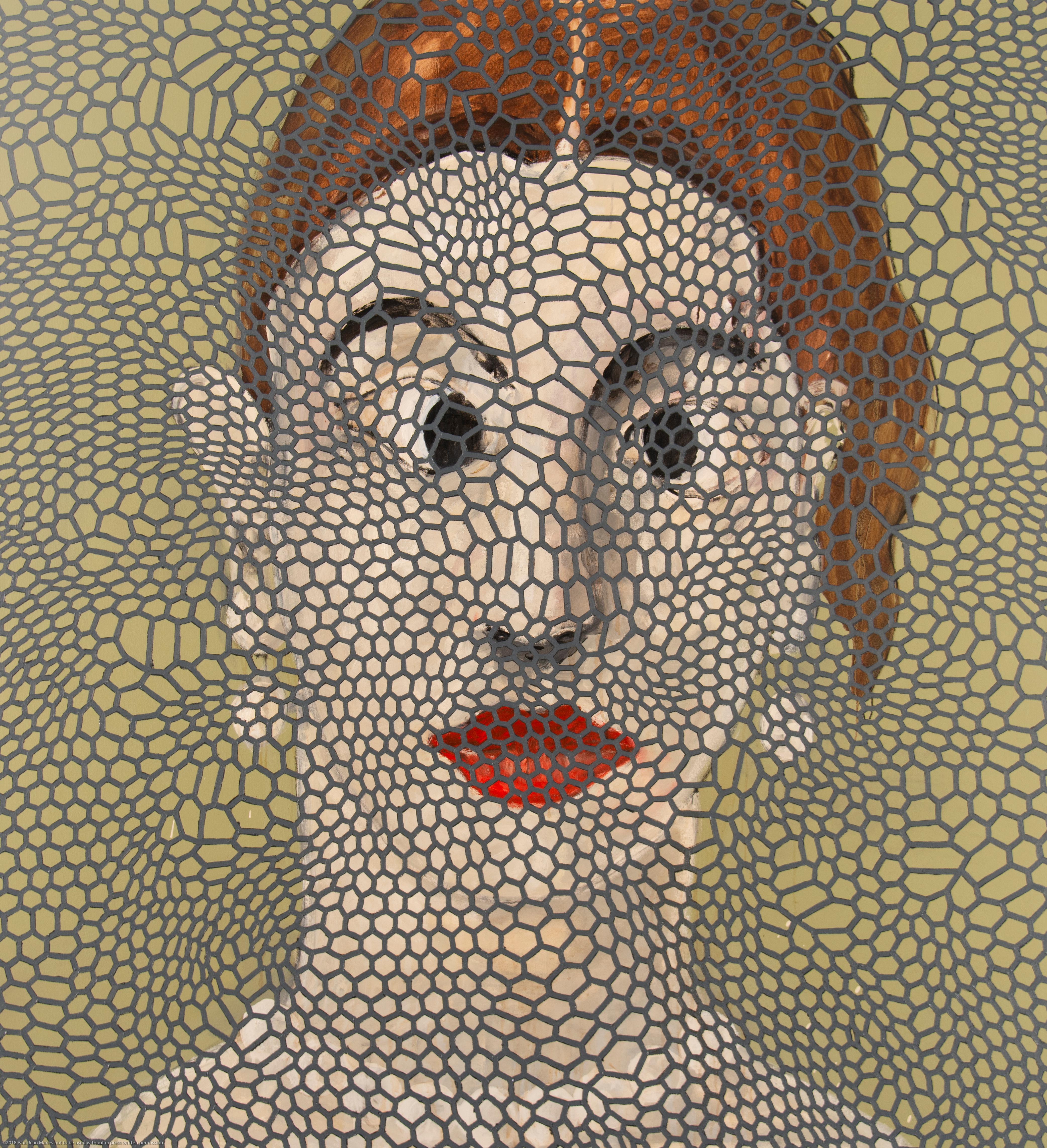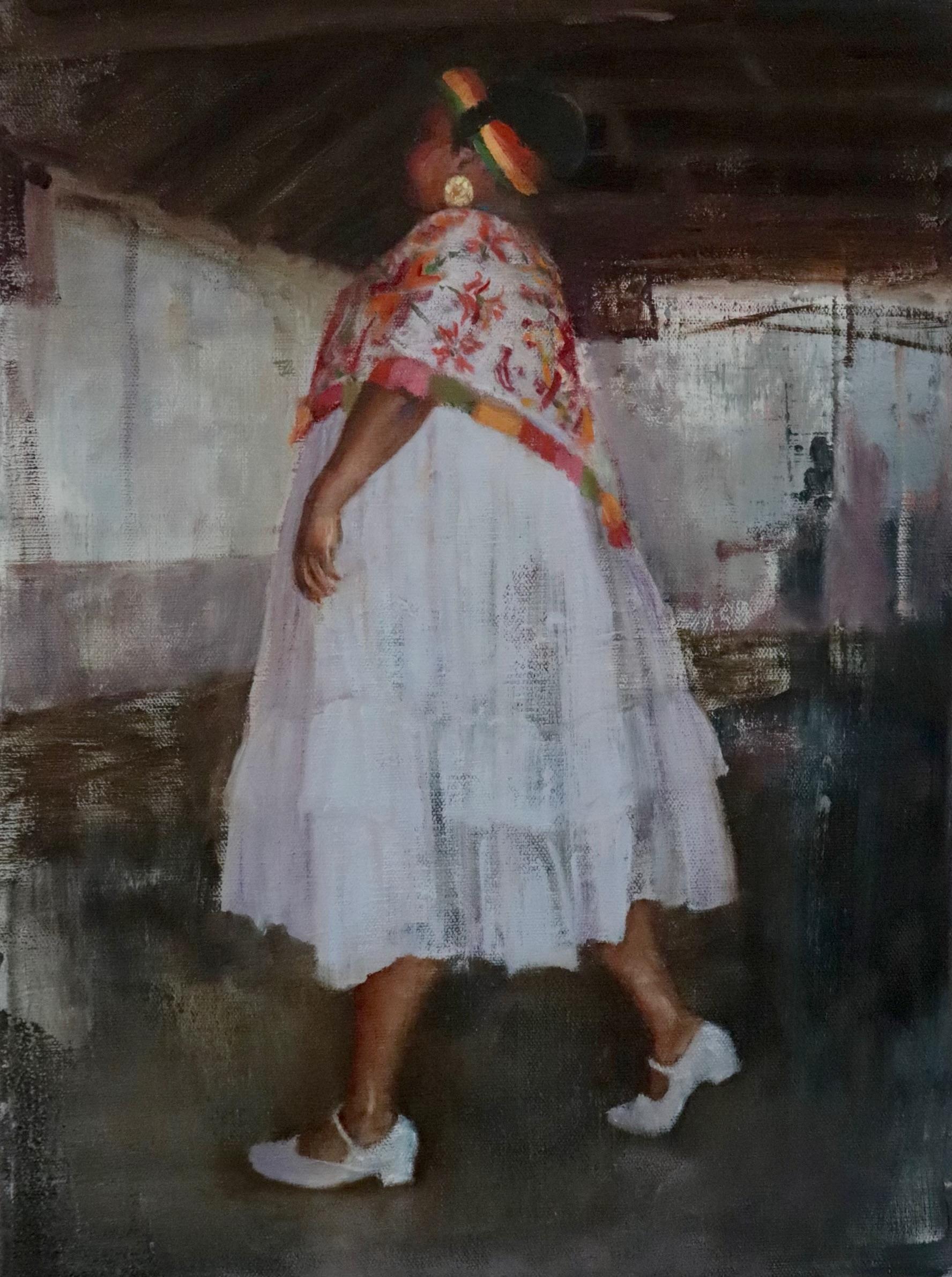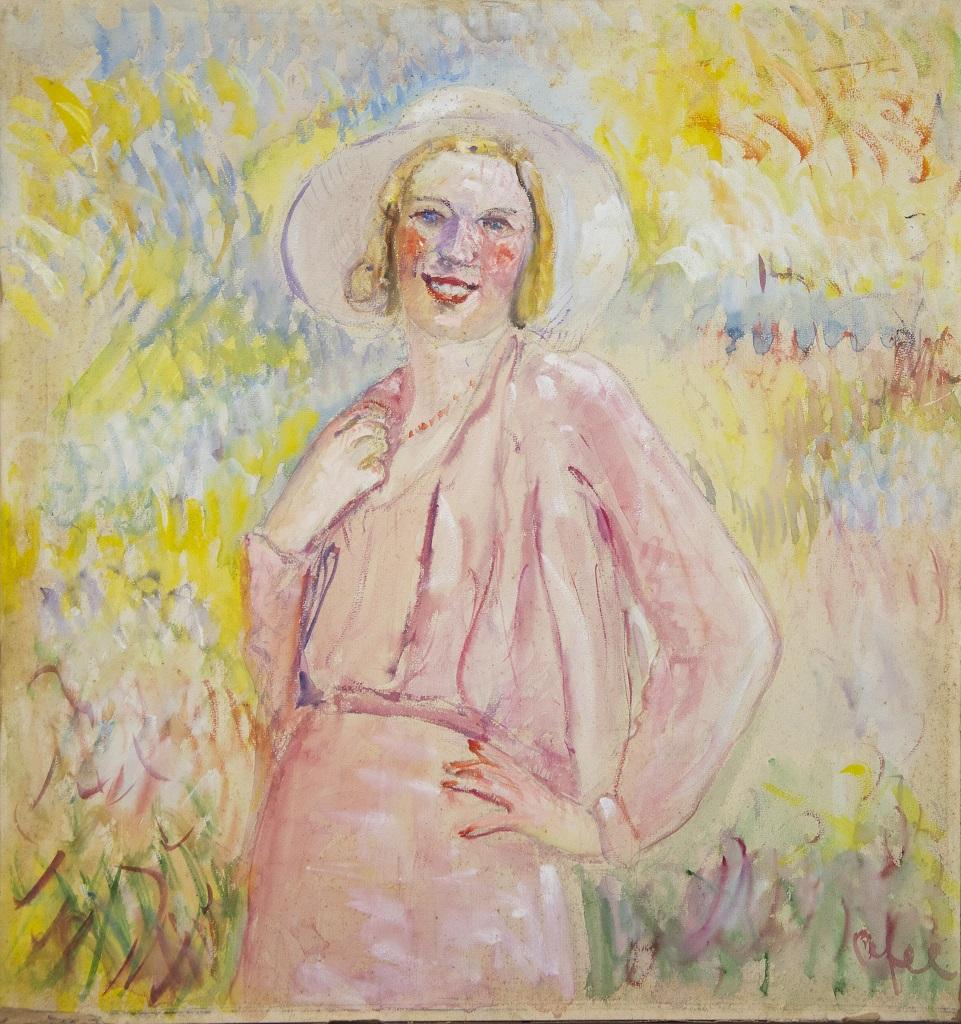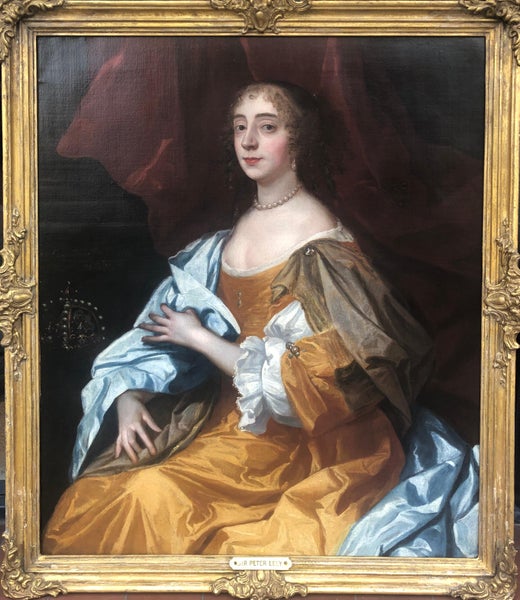Items Similar to Portrait of Bridget Drury Lady Shaw, formerly Viscountess Kilmorey
Want more images or videos?
Request additional images or videos from the seller
1 of 7
Sir Peter LelyPortrait of Bridget Drury Lady Shaw, formerly Viscountess Kilmorey1665
1665
About the Item
Sir Peter Lely (Soest 1618 – 1680 London)
Portrait of lady with a crown, possibly Bridget Drury Lady Shaw, formerly Viscountess Kilmorey, later Lady Baber (d.1696) c.1665
Oil on canvas
46 1/2 x 40 3/4 inches, Framed
42 1/4 x 36 1/4 inches, Unframed
Inscribed left [……….]Isabella
James Mulraine wrote the following for this piece:
This portrait dates to the middle of the 1660s, the decade when Lely’s career took off as successor to Sir Anthony van Dyck. At the Restoration Charles II had appointed him Principal Painter to the King and paid a pension £200 per annum ‘as formerly to Sr. Vandyke...’1 Lely had trained in Haarlem and he was in his early twenties when he came to London in 1643. He was an astute businessman and a wise courtier. In 1650 he painted a portrait of Oliver Cromwell (Birmingham Museum and Art Gallery) while maintaining links with the Royalist exiles through the 1650s. He had arrived in England as a painter of small-scale portraits and lush scenes of nymphs in landscapes in a Dutch style. His experience of Van Dyck in English collections transformed his painting. His lavish and alluring vision of Arcadia exactly captured the spirit of the Court and as Principal Painter he dominated English portraiture for the next twenty years. Lely ran a highly efficient studio along Netherlandish lines, employing a team of specialists like the drapery painter John Baptist Gaspars and young artists-in-training like Nicolas de Largilliere. He had numerous rivals during that period, and by 1670 he had introduced numbered standard poses to speed up production, while collaborating with printmakers for further revenue and advertising. He died in 1680 of a stroke while painting, working to the last.
The portrait, painted at a date when Lely’s poses and execution were still individual and inventive shows a lady sitting at three-quarter length facing away from the viewer. She has begun to turn towards the viewer, a pose with a long pedigree in art, first used by Leonardo da Vinci in the Mona Lisa (Louvre). She steadies her blue drapery where it might slip from her arm with the movement, a flash of realism beautifully captured. Like Van Dyck, Lely painted his female sitters in a timeless costume rather than contemporary fashion, showing a loose gown and floating silk draperies. It presented the sitter as a classical ideal. The portrait would not date.
The saffron dress may be the work of a drapery painter but the brown scarf must be by Lely himself, and appears unfinished, broadly sketched in behind the shoulder. The delicate blue glaze and nervous highlights suggest shimmering translucence. Lely was a master of painting hands – his hand studies are marvels of drawing – and the lady’s hands are superb, exactly drawn, delicately modelled and expressive. The fidgety gestures, clutching the gown, fiddling with the edge of the scarf, give the portrait psychological bite, suggesting the personality behind the calm courtier’s expression, adding to the sense shown in the look of the eyes and mouth that the lady is about to speak. The portrait’s language is Vandykian. The inspiration comes directly from Van Dyck’s English portraits of women. Lely owned Van Dyck’s Portrait of Lady Elizabeth Thimbleby and Dorothy Viscountess Andover (National Gallery, London) and the sitter’s costume quotes Lady Andover’s saffron dress and brown scarf. But Lely paints a generation who sat nearer to the ground and through a dialogue of expression and gesture he shows sitters who are more flesh and blood than Van Dyck’s.
The background with a column and curtain is different to those shown in most of Lely’s portraits of women. They tend to include trees or fountains, with a glimpse of landscape. But there are other examples. A portrait of the King’s reigning mistress, Barbara Villiers Duchess of Cleveland c.1664-5 (Lydiard Park, Swindon Museum and Art Gallery) shows her sitting in front a stone wall and column with a curtain to the left. Elizabeth Hamilton Countess of Gramont c.1663 (Royal Collection) is shown as St Catherine against a plain dark background between a column and a curtain, perhaps as a tribute to Queen Catherine of Braganza. Catherine herself was painted by Lely with a stone and curtain background (engraving by Abraham Blooteling after Lely, c.1678, British Museum). It is a commanding, regal formula.
Our portrait is also regal, very much more so, because a royal crown is shown resting on a ledge below the column, painted with autograph virtuosity in details such as the highlights on the pearls. It is a queen’s crown. The details compare broadly with Catherine of Braganza’s crown shown in Blooteling’s engraving. Comparison of dates – our sitter looks to be in her late 30s in the early/mid 1660s – and likeness found no matches with crowned heads at this date. There is an old two-line inscription painted on the plinth of the column above the crown, overscored and illegible except the final word Isabella. Isabella de Bourbon Queen of Spain (1602 – 1644) was Queen Henrietta Maria’s sister. Portraits in country house collections are sometimes misidentified by later generations. If the inscription was painted on in the Eighteenth Century the identity of a woman with a crown could have been mistaken. But the sitter’s fidgety gesture, and informal dress would be highly unusual in a royal portrait, certainly in one formal enough to include the crown, just as the crown would be an extraordinary addition to a portrait of a non-royal sitter.
One portrait does show a commoner with a Royal Crown, the portrait of Jane Lane Lady Fisher by an unknown artist c.1660 (National Portrait Gallery), shows her holding up the Crown, protecting and venerating it. Jane Lane’s portrait commemorates her role in helping King Charles II escape after the Battle of Worcester, when he travelled in disguise as her servant. Comparing our lady with Lely portraits of this date there is one sitter with a striking resemblance. Lely’s portrait of Bridget Drury Viscountess Kilmorey shows a woman who looks remarkably similar to our sitter (Sotheby’s 13th November 1991 lot 24; ex-collection Earls of Kilmorey).
Bridget Drury (probably born c.1620/25) was the daughter and co-heir of Sir William Drury of Beesthorpe, Norfolk and his wife Mary daughter of William Cokayne, merchant of London. She married Charles Needham younger son of the 2nd Viscount Kilmorey in 1655. Needham succeeded his brother as 4th Viscount Kilmorey in 1657. In August 1659 Lord Kilmorey was one of the commanders of Booth’s Uprising, an unsuccessful Royalist rebellion in Cheshire in August 1659. He was defeated near Chester and imprisoned in London where he died the following year, only months before King Charles II was invited back to England in May. Lady Drury remarried in 1663. Her second husband was Sir John Shaw. Shaw had been merchant in Antwerp during the Civil War and Interregnum. He provided money for King Charles I’s armies and was later a key source of money and information to the King and Court in exile. The Earl of Clarendon ‘wrote at one time that without Shaw the King could not have got bread.’2 At the Restoration Shaw was knighted. He was elected MP for Lyme Regis in 166 and sat until 1678. He was also appointed to a string of lucrative posts including Farmer of the Customs. After his marriage to the widowed Lady Kilmorey the King created him a baronet. At the same date Shaw bought a lease of a royal property, the King’s House at Eltham for £3,700, which he had rebuilt by the Court architect Hugh May as Eltham Lodge. In 1668 ‘Lady Bridget Shaw’ is recorded as a co-defendant with Shaw, Sir Henry Vernon Bt, Sir Peter Leycester Bt and Sir John Booth in an action brought against her son Thomas 6th Viscount Kilmorey.3
Bridget Lady Shaw continued to live at Eltham after her husband’s death in 1680. In 1681 she married Sir John Baber MD (1625 – 1704). Baber had been appointed King Charles II’s doctor and knighted at the Restoration, and being a presbyterian, was used by the King as a go-between in negotiations with religious dissenters. Bridget Lady Baber died at Eltham in July 1696.
At present Bridget Drury’s biography exists only as a wife to her husbands, and as mother to her sons Robert and Thomas, the 5th and 6th Viscounts Kilmorey. The Sotheby’s portrait of Bridget Viscountess Kilmorey raises intriguing questions. The sitter looks dreamily towards the viewer, leaning her head on her right arm, with her elbow resting on a red velvet-draped table. On the table a luscious display of ripe glistening fruits, pendant plums and plump peaches. The sitter’s other arms rests across her lap like an echo of the Medici Venus. Noticeably her bodice is low-cut enough to expose her breast and show her nipple. This detail invariably indicates a portrait of a mistress4, like Lely’s portrait of Diana Kirke Countess of Oxford c.1665-70 (Yale Center for British Art, Paul Mellon Collection) or his lost portrait of Nell Gwynn c.1673 (engraved Peter Valck, National Portrait Gallery).
A version of the Sotheby’s painting was sold at Christie’s 15th June 2001 lot 6 as an unidentified woman. The Christie’s painting was formerly at Crewe Hall near Nantwich in Cheshire, where she was traditionally called Barbara Villiers. This identification was plainly wrong, but it is a handy example, both of the rule that the format indicated a portrait of a mistress, and of the way that portraits in country house collections can be misidentified over time. The provenance is significant. The Kilmorey family were originally from Shropshire, but Bridget’s mother-in-law Eleanor Dutton (d.1665) was a Cheshire heiress. The 2nd Viscount Kilmorey based the family at his wife’s family’s estate at Dutton, and clearly had great interests in the county. The co-defendants in the 1668 case are Cheshire gentry, including a member of the Booth family. The Cheshire provenance of the Christie’s painting certainly supports an identification with Bridget Viscountess Kilmorey. If both portrait types - the regal image with a crown, and the erotically charged paintings from the Kilmorey and Crewe collections – do indeed show Bridget Drury they add a remarkable dimension to a life that is otherwise relatively obscure, and like all women’s lives in this period deserves to be better known.
of Broad Street, Lo
1. Catherine Macleod ‘Good but not like’: Peter Lely, portrait practice and the creation of a Court Look in Catherine Macleod, Julia Marciari Alexander, Kevin Sharpe, Diana Dethloff, Sonya Wynne and David Taylor ‘Painted Ladies Women at the Court of Charles II’ National Portrait Gallery London and Yale Center for British Art, New Haven, p.51
2. ‘Sir John Shaw (c.1615 – 80) of London and Eltham Lodge, Kent in The History of Parliament: the House of Commons 1660-1690, ed. B.D. Henning, 1983
3. Mary Rush, widow v Thomas Viscount Kilmorey and others. 1668, National Archives, Kew C 9/40/72
4. Macleod, Alexander et al. 2001, p.100
- Creator:Sir Peter Lely (1618 - 1680, Dutch)
- Creation Year:1665
- Dimensions:Height: 46.5 in (118.11 cm)Width: 40.75 in (103.51 cm)
- Medium:
- Period:1660-1669
- Condition:
- Gallery Location:London, GB
- Reference Number:1stDibs: LU67336975732
Sir Peter Lely
Sir Peter Lely (1618-1680) was born in Germany at Soest in Westphalia in 1618. Though his family name was van der Faes, he assumed the name Lely after the lily that was carved on the gable of his father’s home in The Hague. He moved to England in 1641, the year that Van Dyck died, and succeeded Van Dyck. He was court painter to Kind Charles I and King Charles II. By working for many of the patrons of the late van Dyck, Lely rapidly established himself as one of the country’s most important portrait painters.
About the Seller
5.0
Vetted Seller
These experienced sellers undergo a comprehensive evaluation by our team of in-house experts.
Established in 1990
1stDibs seller since 2017
40 sales on 1stDibs
Typical response time: 4 hours
- ShippingRetrieving quote...Ships From: London, United Kingdom
- Return PolicyA return for this item may be initiated within 1 day of delivery.
More From This SellerView All
- Portrait of Anne, Lady Russell, later Countess of BedfordBy Anthony van DyckLocated in London, GBA three-quarter length portrait of Anne, Lady Russell, later Countess of Bedford (1615-1684), in a blue dress. Attributed to Sir Anthony Van Dyck. Anne C...Category
17th Century Portrait Paintings
MaterialsOil
- A Full-Length Portrait of Nicholas I of Russia in a Classical SettingLocated in London, GBA Full-Length Portrait of Nicholas I of Russia in a classical setting. Pietro Labruzzi (1739–1805). 1802. Signed, located and dated lower left: ‘Pietro Labruzzi Roma Pinx Anno 1802.’ Oil on canvas. Dimensions: Unframed: 135.7 x 98.5 cm.; 53½ x 38¾ in. Framed: 151.6 x 115.6 cm.; 59¾ x 45½ in. Description: Nicholas I (Russian: Nikolay Pavlovich) (1796-1855), Russian Emperor...Category
Early 1800s Paintings
MaterialsCanvas, Oil
- 18th C. Portrait of the 4th Earl of Sandwich a View of Constantinople BeyondLocated in London, GBJohn Montagu, 4th Earl of Sandwich (13 November 1718 – 30 April 1792) Attributed to George Knapton (1698-1778) Dressed in the Turkish manner, stand...Category
18th Century Old Masters Figurative Paintings
MaterialsOil
- Lady Dormore - A 16th Century Portrait of a key member of Shakespeare's EnglandLocated in London, GBLady Dormer, Mary Browne c. 1592 oil on panel 35 x 29 inches, unframed; 41 x 34.75 inches, inc. frame Inscribed 'Lady Dormore' Mary married Henry Wriothesley, 2nd Earl of Southampton who gave birth to Henry Wriothesley, 3rd Earl of Southampton - one of the great figures in Shakespears"s circle and founder of the Virginia company, developers of Virginia USA. Henry Wriothesley, born 6 October 1573 at Cowdray House, Sussex, was the only son of Henry Wriothesley, 2nd Earl of Southampton, by Mary Browne, the only daughter of Anthony Browne, 1st Viscount Montague, and his first wife, Jane Radcliffe.[5] He had two sisters, Jane, who died before 1573, and Mary (c. 1567 – 1607), who in June 1585 married Thomas Arundell, 1st Baron Arundell of Wardour.[6] After his father's death, Southampton's mother married firstly, on 2 May 1595, as his second wife, Sir Thomas Heneage (d. 17 October 1595), Vice-Chamberlain of the Household, and secondly, between 5 November 1598 and 31 January 1599, Sir William Hervey. She died in November 1607.[7] Early life When his father died on 4 October 1581 Southampton inherited the earldom and landed income valued at £1097 6s per annum. His wardship and marriage were sold by the Queen to her kinsman, Charles, Lord Howard of Effingham, for £1000. According to Akrigg, Howard then "entered into some further agreement, of which no documentation can now be found, which transferred to Lord Burghley personally the custody and marriage of the young Earl, but left Howard holding his lands", and late in 1581 or early in 1582 Southampton, then eight years of age, came to live at Cecil House in the Strand.[8] In October 1585, at age twelve, Southampton entered St John's College, Cambridge,[9] graduating M.A. on 6 June 1589.[10] His name was entered at the Gray's Inn legal society before he left the university, and he was admitted on 29 February 1588.[11] On Southampton's 16th birthday, 6 October 1589, Lord Burghley noted Southampton's age in his diary, and by 1590 Burghley was negotiating with Southampton's grandfather, Anthony Browne, 1st Viscount Montague, and Southampton's mother, Mary, for a marriage between Southampton and Lord Burghley's eldest granddaughter, Elizabeth Vere, daughter of Burghley's daughter, Anne Cecil, and Edward de Vere...Category
16th Century Old Masters Figurative Paintings
MaterialsOil
- 19th Century Oil Painting Portrait of a MuseLocated in London, GBJohn Opie RA (1761-1807, English) c. 1802 Oil on canvas Canvas dimensions 36 x 32 inches Framed dimensions 46.5 x 43.25 inches Original gilded period frame. John Opie was a Corni...Category
Early 19th Century Portrait Paintings
MaterialsOil
- 20th Century Oil Painting Impressionist Portrait of Mother and DaughterBy Georges PicardLocated in London, GBA beautiful french salon double portrait. We adore the wallpaper in the background and the whole in its frame superchic.Category
Early 20th Century Impressionist Portrait Paintings
MaterialsOil
You May Also Like
- Nicholas V. Sanchez - La Brisa, Painting 2021Located in Greenwich, CToil on canvas 48” H x 36” W Nicolas V. Sanchez received his BFA from Kendall College of Art and Design in Grand Rapids, MI and his MFA from the New York Academy of Art. While at the...Category
2010s Contemporary Figurative Paintings
MaterialsCanvas, Oil
- Paul Manes - Woman with Pearls, Painting 2016By Paul ManesLocated in Greenwich, CTPaul Manes was born May 4, 1948 in Austin, Texas. He began his professional career in New York City in the early 1980s. His art has been widely exhibited in America and Europe and hi...Category
2010s Expressionist Portrait Paintings
MaterialsCanvas, Paint, Oil
- Nicholas V. Sanchez - Veracruz Dancer, Painting 2021Located in Greenwich, CToil on canvas 30” H x 40” W Nicolas V. Sanchez received his BFA from Kendall College of Art and Design in Grand Rapids, MI and his MFA from the New York Academy of Art. While at the...Category
2010s Contemporary Figurative Paintings
MaterialsCanvas, Oil
- Nicholas V. Sanchez - Ballerina de Sol, Painting 2021Located in Greenwich, CToil on canvas 16” H x 12” W Nicolas V. Sanchez received his BFA from Kendall College of Art and Design in Grand Rapids, MI and his MFA from the New York Academy of Art. While at th...Category
2010s Contemporary Figurative Paintings
MaterialsCanvas, Oil
- Surreal Portrait, Oil Painting by Richard KirkBy Richard KirkLocated in Long Island City, NYArtist: Richard Kirk, American XXth Title: Surreal Portrait Year: circa 1960 Medium: Oil on Canvas, signed Size: 36 x 24 in. (91.44 x 60.96 cm) Frame:...Category
1960s Surrealist Portrait Paintings
MaterialsOil
- Woman in Pink - Oil Painting by Antonio Feltrinelli - 1930sBy Antonio FeltrinelliLocated in Roma, ITWoman in pink is an original artwork realized by the Italian artist Antonio Feltrinelli in the 1930s. Original oil on plywood. Beautiful and representative work of a female figure...Category
1930s Modern Figurative Paintings
MaterialsOil





